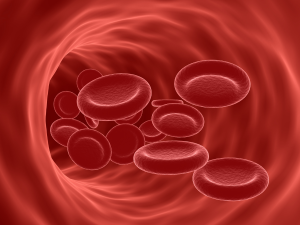February 2023
Scenario for Acute Blood Loss Anemia: 56 yr. old male admitted for radical right nephrectomy of the right kidney for cancer. The patient has a history of hypertension and is on metoprolol.
- Pre-Op Labs: WBC 7.8, Hgb 13.5, Plt count 244
- OP Note: Right Radical Nephrectomy with EBL 200
- Vitals Post-Op: T 98.2, HR 92, R 20, BP 122/68, SP02 95% on 2L/NC
- Post Op Day 1: T 98.4, HR 110, RR 22, BP 106/50. Hgb 9.2. Patient c/o some lightheadedness when up and walking. The nurse reports small amount of pink tinged urine with a few blood clots in the Foley catheter. Orders for H/H Q6H, irrigation to Foley catheter as needed for hematuria, and hold AM blood pressure medication.
- Post Op Day 2: T 98.0, HR 100, RR 20, BP 112/58. Hemoglobin over past 24 hours ranged from 8.3-9.0. Nurse reports that the Foley catheter is still having a small amount of blood. Patient still feeling lightheaded with ambulation at times, but it is getting better. Start patient on ferrous sulfate 325 mg BID and hold discharge for today.
- Post Op Day 3: HR 90, R 18, BP 132/78. Patient states he is feeling much better. The last 2 hemoglobin levels were 8.9. Nurse reports the Foley catheter is draining clear yellow urine. Resume blood pressure medication today and discharge home.
- Discharge Summary: Patient with cancer of the right kidney status post right nephrectomy. Discharge home with Foley catheter in place. Follow up appointment in 2-3 days.
Definition of Acute Blood Loss Anemia: “Acute blood-loss anemia may occur following surgery, but it is not necessarily a complication of the procedure and should not be coded as a postoperative complication unless the physician identifies it as such.” – Diseases of the Blood and Blood-Forming Organs and Certain Disorders Involving the Immune Technicisms – AHA Coding Handbook

Question: Are there query opportunities based on the scenario stated above?
Patient with Indicators of Acute Blood Loss Anemia:
- Hemoglobin on pre-op labs was 13.5 and dropped to between 8.3-9.0
- BP 106/50, HR 110
- c/o lightheadedness
- Foley catheter with streaks of blood
- OP note with EBL 100
- Treatment for acute blood loss anemia included ferrous sulfate, an extra day LOS, serial H/H, monitoring vital signs, holding blood pressure medication
UASI Recommends:
- Query for postoperative acute blood loss anemia:
Documentation without Clarification:
- Principal Diagnosis: Malignant neoplasm of right kidney, except renal pelvis (C64.1)
- Secondary Diagnoses: Hypertension (I10), Hematuria, unspecified (R31.9)
- Procedure Code: Resection of Right Kidney, percutaneous endoscopic approach (0TT04ZZ)
- Working DRG: 658 Kidney and ureter procedures for neoplasm without CC/MCC
- RW=1.579 GMLOS=1.8 SOI/ROM: 1/1
Documentation with Clarification:
- Principal Diagnosis: Malignant neoplasm of right kidney, except renal pelvis (C64.1)
- Secondary Diagnoses: Hypertension (I10), Hematuria (R31.9), acute blood loss anemia (D62)
- Procedure Code: Resection of Right Kidney, percutaneous endoscopic approach (0TT04ZZ)
- Working DRG: 657 Kidney and ureter procedures for neoplasm with CC
- RW=1.878 GMLOS=2.8 SOI/ROM: 1/1
CDI Educational Tips:
- Clinical Indicators for Acute Blood Loss Anemia:
- Look for a hemoglobin drop of 1.0-2.0 gm/dl with symptoms of shortness of breath, hypotension, weakness, or dizziness.
Treatment to Look for to Support a Diagnosis of Acute Blood Loss Anemia:
- Serial H/H
- Blood transfusion
- Frequent Vital Sign Monitoring
- Iron Supplements
- FFP Transfused
- Increased LOS for Monitoring
“When anemia is documented without specification of acute blood loss, code D64.9, Anemia, unspecified, is the default.” – Diseases of the Blood and Blood-Forming Organs and Certain Disorders Involving the Immune Technicisms – AHA Coding Handbook
This is a short synopsis of a possible patient record and is not intended to be all inclusive. This is for educational purposes only and not intended to replace your institutional guidelines.
To view previous CDI scenarios, click here.